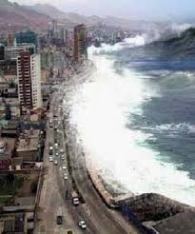Pangea, that means ”all lands”(The term began being used in the early 20th century after Alfred Wegener noticed that the Earth’s continents looked like they fit together like a jigsaw puzzle. He later developed his theory of continental drift to explain why the continents looked the way they did and first used the term Pangea at a symposium in 1927 focused on that topic), was a supercontinent that existed on the Earth millions of years ago and covered about one-third of its surface. A supercontinent is a very large landmass that is made up of more than one continent. In the case of Pangea nearly all of the Earth’s continents were connected into one large landmass. It is believed that Pangea began forming about 300 million years ago, was fully together by 270 million years ago and began to separate around 200 million years ago.
Due to mantle convection within the Earth’s surface new material constantly comes up between the Earth’s tectonic plates at rift zones, causing them to move away from the rift and toward one another at the ends. In the case of Pangea, the Earth’s continents were eventually moved so much over millions of years that they combined into one large supercontinent.
Around 300 million years ago the northwestern part of the ancient continent of Gondwana (near the South Pole), collided with the southern part of the Euramerican continent to form one very large continent. Eventually the Angaran continent, located near the North Pole, began to move south and it collided with the northern part of the Euramerican continent to form the large supercontinent, Pangea, by about 270 million years ago.
It should be noted however that there was another separate landmass, Cathaysia, which was made up of north and south China that was not a part of the larger Pangea landmass.
Once it was completely formed, Pangea covered around one-third of the Earth’s surface and it was surrounded by an ocean that covered the rest of the globe. This ocean was called Panthalassa.
Pangea began to break up about 200 million years ago as a result of the movement of the Earth’s tectonic plates and mantle convection. Just as Pangea was formed by being pushed together due to the movement of the Earth’s plates away at rift zones, a rift of new material caused it to separate. Scientists believe that the new rift began due to a weakness in the Earth’s crust. At that weak area, magma began to push through and create a volcanic rift zone. Eventually the rift zone grew so large that it formed a basin and Pangea began to separate.
In the areas where Pangea began to separate, new oceans formed as Panthalassa rushed into the newly opened areas. The first new oceans to form were the central and southern Atlantic. About 180 million years ago the central Atlantic Ocean opened up between North America and northwestern Africa. Around 140 million years ago the South Atlantic Ocean formed when what is today South America separated from the west coast of southern Africa. The Indian Ocean was the next to form when India separated from Antarctica and Australia and about 80 million years ago North America and Europe separated, Australia and Antarctica separated and India and Madagascar separated. Over millions more years, the continents gradually moved to their current positions.
s Alfred Wegener noticed in the early 20th century, the Earth’s continents seem to fit together like a jigsaw puzzle in many areas around the globe. This is the significant evidence for the existence of Pangea millions of years ago. The most prominent place where this is visible is the northwestern coast of Africa and the eastern coast of South America. In that location the two continents look like they were once connected, which they in fact were during Pangea.
Other evidence for Pangea includes fossil distribution, distinctive patterns in rock strata in now unconnected parts of the world and the distribution of the world’s coal. In terms of fossil distribution, archaeologists have found matching fossil remains if ancient species in continents are separated by thousands of miles of ocean today. For example matching reptile fossils have been found in Africa and South America indicating that these species at one time lived very close to each other as it is not possible to them to have crossed the Atlantic Ocean.
Patterns in rock strata are another indicator for the existence of Pangea. Geologists have discovered distinctive patterns in rocks in continents that are now thousands of miles apart. By having matching patterns it indicates that the two continents and their rocks were at one time one continent.
Finally the world’s coal distribution is evidence for Pangea. Coal normally forms in warm, wet climates. However geologists have found coal under Antarctica’s very cold and dry ice caps. If Antarctica were a part of Pangea it is likely that it would have been in another location on the Earth and the climate when the coal formed would have been very different than it is today.




















